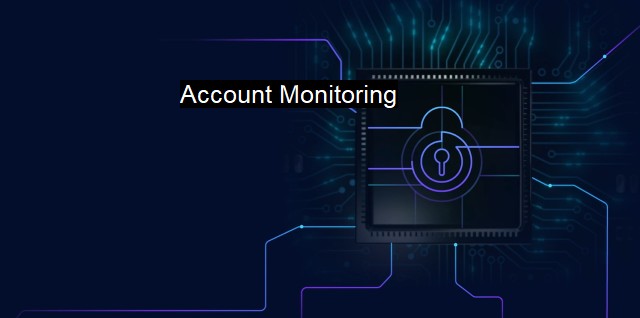What is Account Monitoring?
The Importance of Account Monitoring in Cybersecurity: Detecting Malicious Activity and Securing Sensitive Information
Account monitoring plays a crucial role in maintaining a robust cybersecurity landscape. It is an active and continuous process of observing and examining user activity across various systems. This cybersecurity practice is used to perceive, deter, and respond to an array of risks and threats encompassing, but not limited to, unauthorized access, information misuse, and information leakage. Accordingly, this enhances system integrity and information security within an organization.Account monitoring operates in an encapsulating manner, retrieving critical insights from different sources, testing data fidelity and discerning patterns predominantly humanly inconceivable. This stalwart cybersecurity practice pierces its gaze over multiple echelons, inspecting activities at account endpoints, thereby offering scrumptious morsels of data describable of user action sequences.
At its core, account monitoring is tasked with executing due diligence on the engagement of user accounts and assessing the terrain for deviated interactions and abnormal user behaviour. Into this inquest falls accesses gained externally or achieved perspicaciously from within the system. Should oddest patterns surface, as a shrill alarm, account monitoring pronounces instant notifications for technicians' engagement. This empowers administrators with agility during response, and room to thwart further intrusion.
Simultaneously, by informing discerned risks, account monitoring aids organizations in marshalling regulatory demands imposed by legislative bodies, vpertinent to securing user data. Organizations, therefore are assisted moving voraciously within legal guidelines tailoring cybersecurity stipulations, protecting them from permeable vulnerabilities and exposure to legal labyrinths.
Data procured by the cybersecurity program are manipulated into logs showcasing keyword-related flags, odd user practices and heuristic graphs, demonstrable of trends over varied time sets. These files shared with teams, thence expand their understanding about sore attack surfaces and fortitude-bordering strategies. This facilitates...
Neurotically diligent and strategic reworking of defenses, employing lessons learnt from log extracts fortify protects from recurring penetrations and attempts. Similar protection strategies can be employed cross-organizationally, creating a 'unified-in defense', a network safe from collective threats.
The lifeline of account monitoring entwines indisputably at ends with antivirus softwares. Each movement within a system embarks from user accounts that naturally need UI and admin account accesses - on frontier antivirus favorite. Thus on logging these user-account-backed activities, antivirus softwares can delineate spanning cues to perform antivirus scans, protect against threats, and salvage systems post-attacks.
Venturing into user-access-based activity traps gives the antivirus software rare distinguishing evidence of malicious activities before they escalate havoc. Antivirus programs, in their bid to further relations with account monitoring, package with informative alerts issuing threats in real-time. On alert, other processes instantaneously follow to isolate potential threats or neutralize those existent within the already devised boundaries.
Antivirus software catalogs the detailed history of previous risks flags including types and timings, providing engineers the relational link among all infiltrations. Toggling through concerns:relative payloads dropped, modulated surgeries performed by some virus establish linkages among affects and chronological evictions. This simplifies perceptions surrounding the attack mode plotting expansive reduces over reconnaissance and potential material impact, helping authorities tackle cyber attack issues more efficiently.
With commerce is turning web-ward and información being the formulation game's powerhouse, account monitoring punctuates need more than ever, to discount disastrous eclipse hacking causes onusat infrastructure.
Individually linuxographed, users are encapsulated, their account vitalities constantly cognized and pronounced sealed within an invincible cocoon security gluon. Arriving freshly into the competitive scene are developers innovating AI fronts advancing the purpose of natural anomaly detections and fetching deeper-looming insights of our starkososre digital world. As soon cybersecurity, account monitoring will be the practisedmight quandary at hand, away from parsimonious sketches. It unarguably cements integrity principles into account activities, hence why in cybersecurity and antivirals, staunch integration with account monitoring finds legitimacy.

Account Monitoring FAQs
What is account monitoring in the context of cybersecurity and antivirus?
Account monitoring refers to the process of actively watching over user accounts to detect suspicious or unauthorized activities that may indicate a security threat. This can include monitoring of login attempts, changes to account settings, and unusual patterns of behavior.Why is account monitoring important for cybersecurity?
Account monitoring can help identify potential security breaches and stop them before they cause damage. It allows security professionals to quickly detect and respond to threats, including those originating from malicious software and attackers attempting to steal sensitive data.How is account monitoring different from antivirus software?
Antivirus software is designed to detect and remove known malware and viruses from a system, while account monitoring focuses on detecting unauthorized or unusual behavior within user accounts. While both are important components of a comprehensive cybersecurity strategy, they serve different functions and may require different tools and techniques.What are some best practices for account monitoring?
Some best practices for account monitoring include setting up automated alert notifications for suspicious activity, regularly reviewing security logs and user access permissions, and implementing multi-factor authentication for sensitive accounts. It's also important to regularly review and update security policies and procedures to ensure they are aligned with current threats and industry best practices.| | A | | | B | | | C | | | D | | | E | | | F | | | G | | | H | | | I | | | J | | | K | | | L | | | M | |
| | N | | | O | | | P | | | Q | | | R | | | S | | | T | | | U | | | V | | | W | | | X | | | Y | | | Z | |
| | 1 | | | 2 | | | 3 | | | 4 | | | 7 | | | 8 | | |||||||